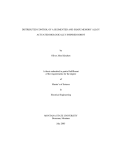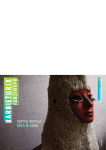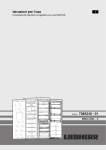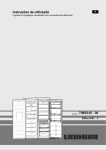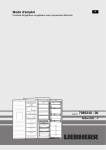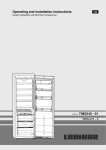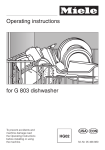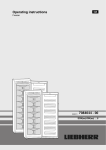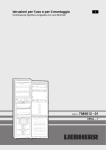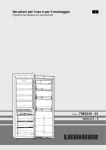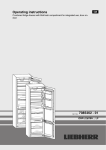Download Operating instructions 180612 7085240 - 00
Transcript
Operating instructions Combined fridge-freezer with BioFresh compartment 180612 7085240 - 00 SBSes 8283 ... 6 Appliance at a glance Contents 1 1.1 1.2 1.3 1.4 1.5 Appliance at a glance............................................ Description of appliance and equipment.................. Range of appliance use............................................ Conformity................................................................ Saving energy.......................................................... HomeDialog............................................................. 2 2 2 3 3 3 2 General safety information................................... 3 3 3.1 3.2 Controls and displays........................................... Operating and control elements............................... Temperature display................................................. 4 4 4 4 4.1 4.2 4.3 4.4 4.5 Putting into operation............................................ Transporting the appliance....................................... Installing the appliance............................................. Disposing of packaging............................................ Connecting the appliance......................................... Switching on the appliance....................................... 4 4 4 5 5 5 5 5.1 5.2 5.3 5.4 5.5 5.6 5.7 5.8 Control.................................................................... 6 Brightness of the temperature display...................... 6 Contrast of the temperature display.......................... 6 Child proofing........................................................... 6 Door alarm................................................................ 6 Temperature alarm................................................... 6 Refrigerator compartment........................................ 7 BioFresh compartment............................................. 8 Freezer compartment............................................... 10 6 6.1 6.2 6.3 6.4 6.5 6.6 Maintenance........................................................... Changing the water filter........................................... Defrosting with NoFrost............................................ Cleaning the appliance............................................. Cleaning the IceMaker............................................. Cleaning the dispensing unit.................................... Customer service..................................................... 7 Malfunction............................................................. 14 8 8.1 8.2 8.3 Decommissioning.................................................. Shut off the water intake........................................... Switching off the appliance....................................... Taking the appliance out of service.......................... 9 Disposing of the appliance................................... 16 12 12 13 13 13 13 14 16 16 16 16 The manufacturer works constantly on the further development of all the types and models. Therefore please understand that we have to reserve the right to make design, equipment and technical modifications. To get to know all the benefits of your new appliance, please read the information contained in these instructions carefully. Instructions for action are marked with a action are marked with a . , the results of 1 Appliance at a glance 1.1 Description of appliance and equipment Note u Place food inside the appliance as shown in the diagram. This allows the appliance to save energy during operation. u Shelves, drawers and baskets are arranged for optimum energy efficiency on delivery. 2 Fig. 1 (1) Drawer for herbs and berries (2) Cold storage accumulators (3) Ice storage container (4) Drawer, small (5) Dispensing unit (6) Shelf (7) Drawer, large (8) Variospace (9) Type plate Freezer compartment (10) Ice chute (11) Fan (12) Water filter (13) LED interior light (14) Boxes, removable (15) Rack for preserves, relocatable (16) Bottle rack (17) Glass shelves, relocatable (18) Glass shelf, sectioned, relocatable (19) Bottle shelf (20) Control panel for BioFreshPlus compartment (21) BioFreshPlus compartment with Dry/Hydrosafe (22) BioFresh compartment with Dry/Hydrosafe (23) Dry/Hydrosafe regulator (24) Grille for circulating air (25) BioFresh lighting (26) Type plate, refrigerator and BioFresh compartment (27) Safety switch (28) Dispenser (29) Ice dispenser (30) Water dispenser (31) Control panel for freezer and refrigerator 1.2 Range of appliance use The appliance is suitable solely for cooling food in a domestic environment or similar. This includes use in, for example - in staff kitchenettes, bed and breakfast establishments, - by guests in country homes, hotels, motels and other forms of accommodation, - in catering and similar services in the wholesale trade Use the appliance solely as is customary within a domestic environment. All other types of use are inadmissible. The appliance is not suitable for storing and cooling medicines, blood plasma, laboratory preparations or similar substances and products covered by the 2007/47/EC Medical Devices Direc- General safety information tive. Misuse of the appliance can result in the stored products suffering harm or perishing. Furthermore, the appliance is not suitable for operation in potentially explosive atmospheres. The appliance is set to operate within specific ambient temperature limits according to its climate rating. The correct climate rating for your appliance is indicated on the type plate. Note u Compliance with the ambient temperatures indicated is required, otherwise the cooling performance is reduced. Climate rating for ambient temperatures of SN 10 °C to 32 °C N 16 °C to 32 °C ST 16 °C to 38 °C T 16 °C to 43 °C 1.3 Conformity The refrigerant circuit is tested for leakage. The appliance complies with the relevant safety regulations and EC Directives 2006/95/EC, 2004/108/EC, 2009/125/EC and 2010/30/EU. The BioFresh compartment satisfies the requirements of a chill compartment to EN ISO 15502. 1.4 Saving energy - Always ensure good ventilation. Do not cover ventilation openings or grille. - Always keep fan louvres clear. - Do not place appliance in areas of direct sunlight or next to a stove, heater or similar object. - The energy consumption depends on the installation conditions, e.g. the ambient temperature (see 1.2) . - Keep the time the appliance is open to a minimum. - The lower the temperature setting, the higher the power consumption. - Store food logically. (see Appliance at a glance). - Ensure that all food is well packed and covered for storage. This will prevent frost from forming. - Remove food as needed in order that it does not warm too much. - First cool warm food to room temperature before storing it . - Defrost frozen food in the refrigerator. - Use the vacation function for longer vacation periods . Accumulated dust increases the energy consumption: - Once a year, dust the refrigerating unit together with the metal grille of the heat exchanger at the back of the appliance. 1.5 HomeDialog Depending on model and options, the HomeDialog system can be used to network a number of Liebherr appliances (situated, for example, in the basement) with a main appliance (sited, for example, in the kitchen) and control them via the latter. You will find more information on the benefits, requirements and principle of operation on the internet at www. liebherr.com. 2 General safety information Danger for the user: - This appliance is not designed for persons (including children) with physical, sensory or mental impairment or persons not having sufficient experience and knowledge, unless they are instructed in the use of the appliance and are initially supervised by a person responsible for their safety. Keep children under supervision to ensure they do not play with the appliance. - When disconnecting the appliance from the supply, always take hold of the plug. Do not pull the cable. - In the event of a fault pull out the mains plug or deactivate the fuse. - Do not damage the mains power cable. Do not operate the appliance with a defective mains power cable. - Have any repairs to or intervention in the appliance, and any change of the mains power cable, carried out by the customer service only or by other specialised personnel trained for the purpose. - Install and connect the appliance only as instructed. - Please keep these instructions in a safe place and pass them on to any subsequent owners. - The safety switch (see 1.1) has always to be free-moving in order that the control panel is disabled when the door is open. - All repairs to and intervention in the IceMaker may be carried out only by service personnel or by other skilled personnel trained for the purpose. - The manufacturer is not liable for damage caused by a faulty fixed water connection. - Special-purpose lamps (incandescent lamps, LEDs, fluorescent tubes) in the appliance serve to illuminate the appliance interior and are not suited for room illumination. Fire hazard: - The refrigerant R 600a is environmentally friendly but flammable. Escaping refrigerant may ignite. • Do not damage the refrigerant circuit pipes. • Do not allow naked flames or ignition sources to enter the appliance. • Do not use any electrical appliances in the interior (e.g. steam cleaners, heaters, ice cream maker etc.). • If refrigerant escapes: remove any naked flames or sources of ignition from the leakage area. Ventilate the room well. Notify the after-sales service. - Do not store explosives or sprays using combustible propellants such as butane, propane, pentane, etc. in the appliance. To identify these spray cans, look for the list of contents printed on the can, or a flame symbol. Gases possibly escaping may ignite due to electrical components. - Keep burning candles, lamps and other items with naked flames away from the appliance so that they do not set the appliance on fire. - Always store high-percentage alcohol in tightly sealed, upright containers. Alcohol possibly escaping may ignite due to electrical components. Danger of tipping and falling: - Do not misuse the plinth, drawers, doors etc. as a step or for support. This applies particularly to children. Danger of food poisoning: - Do not consume food which has been stored too long. Danger of frostbite, numbness and pain: - Avoid lasting skin contact with cold surfaces or refrigerated/ frozen food or take protective steps, e.g. wear gloves. Do not consume ice cream, water ice or ice cubes immediately and do not consume them too cold. Risk of crushing - Do not reach into the soft stop mechanism. Fingers may be trapped when the door is closed. 3 Controls and displays Please observe the specific information in the other sections: DANGER identifies a situation involving direct danger which, if not obviated, may result in death or severe bodily injury. WARNING identifies a dangerous situation which, if not obviated, may result in death or severe bodily injury. CAUTION identifies a dangerous situation which, if not obviated, may result in minor or medium bodily injury. NOTICE identifies a dangerous situation which, if not obviated, may result in damage to property. Note identifies useful information and tips. 3 Controls and displays 3.1 Operating and control elements Both appliances can be operated using the control panel of the freezer compartment. (20) Alarm symbol (21) Appliance child lock symbol (22) Freezer compartment temperature display (26) Refrigerator compartment temperature display (27) Filter change symbol 3.2 Temperature display The following are displayed in normal operation: - the warmest freezing temperature - the average cooling temperature The freezer compartment temperature display flashes: - the temperature setting is being changed - after switch-on the temperature is not yet cold enough - the temperature has risen several degrees Dashes flash in the display: - the freezer temperature is above 0 °C. The following displays indicate malfunction. Possible causes and corrective action (see Malfunction). - F0 to F9 - FE - nC - The power failure symbol shines. 4 Putting into operation 4.1 Transporting the appliance CAUTION Risk of injury and danger of damage as a result of incorrect transport! u Transport the appliance in a packed condition. u Transport the appliance upright. u Do not transport the appliance without assistance. Fig. 2 (A) Freezer compartment controls (1) On/Off button, freezer (4) Down setting button, compartment freezer compartment (2) Alarm button (5) Up setting button, freezer compartment (3) SuperFrost button (B) Refrigerator compartment controls (6) Up setting button, refrig- (9) Holiday button erator compartment (7) Down setting button, (10) On/Off button, refrigerator refrigerator compartcompartment ment (8) SuperCool button (C) Dispenser controls (11) On/Off button, (14) Filter change button dispenser unit (12) Ice cubes button (15) Dispenser paddle lock button (13) Crushed ice button (16) Light button (D) Symbols and displays (17) Menu symbol (23) Power failure symbol (18) HomeDialog symbol (24) Super Frost symbol (19) SuperCool symbol (25) IceMaker symbol 4 4.2 Installing the appliance WARNING Fire hazard due to dampness! If live parts or the mains lead become damp this may cause short circuits. u The appliance is designed for use in enclosed areas. Do not operate the appliance outdoors or in areas where it is exposed to splash water or damp conditions. WARNING Risk of fire due to short circuit! If the mains cable/connector of the appliance or of another appliance touch the rear of the appliance, the mains cable/ connector may be damaged by the appliance vibrations, leading to a short circuit. u Stand the appliance so that it is not touched by connectors or main cables. u Do not plug the appliance or any others into sockets located near the rear of the appliance. Putting into operation 4.3 Disposing of packaging WARNING Fire hazard due to refrigerant! The refrigerant R 600a is environmentally friendly but flammable. Escaping refrigerant may ignite. u Do not damage the piping of the refrigeration circuit. WARNING Fire hazard and danger of damage! u Do not place appliances emitting heat e.g. microwaves, toasters etc. on the appliance! WARNING Blocked ventilation openings pose a risk of fire and damage! u Always keep the ventilation openings clear. Always ensure that the appliance is properly ventilated! q In the event that the appliance is damaged, contact the supplier immediately before connecting to the mains. q The floor at the site must be flat and level. q Do not install the appliance in a location where it is exposed to direct radiation of the sun, next to a cooker, heater and similar. q Always stand the appliance with its back directly to the wall. q The appliance may be moved only when it is empty. q Do not install the appliance without assistance. q Standard EN 378 specifies that the room in which you install your appliance must have a volume of 1 m2 per 8 g of R 600a refrigerant used in the appliance. If the room in which the appliance is installed is too small, a flammable gas-air mixture may form in the event of a leakage in the refrigeration circuit. The quantity of refrigerant used in your appliance is indicated on the type plate on the inside of the appliance. u Detach the connecting cable from the rear of the appliance, removing the cable holder at the same time because otherwise there will be vibratory noise! u Remove the protective film from the outside of the appliance. NOTICE The stainless steel doors are provided with a high-quality surface coating and must not be treated using the accompanying care product. Otherwise the surface coating will be affected. u Wipe the coated door surfaces using a soft, clean cloth only. u Apply a stainless steel cleaner only to the stainless steel side walls evenly, wiping with the grain. Subsequent cleaning becomes easier as a result. u Wipe side walls with a paint finish using a soft, clean cloth only. u Remove all transit supports. u Dispose of packaging material (see 4.3) . u Mount the appliances according to the separate installation instructions. Note u Clean the appliance (see 6.3) . If the appliance is installed in a very damp environment, condensate may form on the outside of the appliance. u Always see to good ventilation at the installation site. WARNING Danger of suffocation due to packing material and plastic film! u Do not allow children to play with packing material. The packaging is made of recyclable materials: - corrugated board/cardboard - expanded polystyrene parts - polythene bags and sheets - polypropylene straps - nailed wooden frame with polyethylene panel* u Take the packaging material to an official collecting point. 4.4 Connecting the appliance NOTICE Risk of damage to the electronic control system! u Do not use stand-alone inverters (conversion of d.c. to a.c./ three-phase) or energy saving plugs. WARNING Fire and overheating hazard! u Do not use extension cables or multiple socket outlets. The type of current (alternating current) and voltage at the installation site have to conform with the data on the type plate (see Appliance at a glance). The socket must be properly earthed and fused. The tripping current for the fuse must be between 10 A and 16 A. It must be easily accessible so that the appliance can be quickly disconnected from the supply in an emergency. It must be outside the area of the rear of the appliance. Keep to the distance measurements to the socket outlet. u Check the electrical connection. u Plug in the power plug. 4.5 Switching on the appliance Note u The appliances can be switched on and off independently of each other. Switch on the appliance approx. 2 hours before adding frozen food for the first time. Do not load food to be frozen before the temperature display reads -18 °C. 4.5.1 Switching on the freezer compartment u Press On/Off button, freezer compartment Fig. 2 (1). w The temperature display of the freezer compartment and the alarm symbol flash until the temperature is sufficiently low. If the temperature is above 0 °C, dashes flash. If it is below, the current temperature flashes. w If "DEMO" is displayed, demo mode is activated. Please contact the after sales service. 4.5.2 Switching on refrigerator and BioFresh compartment u Press On/Off button, refrigerator compartment Fig. 2 (10). w The interior light is on when the door is opened. 5 Control w The temperature display shines. Refrigerator and BioFresh compartment are switched on. 4.5.3 Switching on the dispensing unit To switch on the dispensing unit: (see 5.8.11) . 5 Control You can adjust the brightness of the temperature display to the light conditions of the room in which the appliance is installed. 5.1.1 Adjusting the brightness The brightness is adjustable between h0 (no illumination) and u To activate the setting mode: press the SuperFrost button Fig. 2 (3) for about 5 s. w The display indicates c. w The menu symbol Fig. 2 (17) shines. u Using the Up setting button, freezer compartment Fig. 2 (5) or Down setting button, freezer compartment Fig. 2 (4), select h. u To confirm: briefly press the SuperFrost button Fig. 2 (3). u To make the display brighter: press Up button, freezer compartment Fig. 2 (5). u To make the display darker: press Down button, freezer compartment Fig. 2 (4). u To confirm: press SuperFrost button Fig. 2 (3). w The brightness is adjusted to the new value. u To deactivate the set-up mode: press On/Off button, freezer compartment Fig. 2 (1). -oru Wait for 5 minutes. w The temperature is indicated again in the temperature display. 5.2 Contrast of the temperature display You can adjust the contrast between lettering and background in the temperature display. 5.2.1 Adjusting the contrast The contrast can be adjusted between 1 (low contrast) and 9 (high contrast). u To activate the setting mode: press SuperFrost button Fig. 2 (3) for about 5 s. w The display indicates C. w The menu symbol Fig. 2 (17) shines. u Using the Up setting button, freezer compartment Fig. 2 (5) or Down setting button, freezer compartment, Fig. 2 (4) select C. u To confirm: briefly press SuperFrost button Fig. 2 (3). u For a higher contrast setting: press Up button, freezer compartment Fig. 2 (5). u For a lower contrast setting: press Down button, freezer compartment Fig. 2 (4). u To confirm: press SuperFrost button Fig. 2 (3). w The contrast is set to the new value. 6 w The temperature is indicated again in the temperature display. 5.3 Child proofing 5.1 Brightness of the temperature display h5 (maximum luminosity). u To deactivate the setting mode: press On/Off button, freezer compartment Fig. 2 (1). -oru Wait for 5 minutes. The child-proofing function enables you to make sure that the appliance is not inadvertently switched off by playing children. 5.3.1 Setting the child lock function u To activate the setting mode: press SuperFrost button Fig. 2 (3) for about 5 s. w The display indicates c. w The menu symbol Fig. 2 (17) shines. u Briefly press the SuperFrost button Fig. 2 (3).to confirm. When c1 is indicated in the display: u Tto activate the child lock, briefly press the SuperFrost button Fig. 2 (3). w The child lock symbol Fig. 2 (21) shines. c flashes in the display. When c0 is indicated in the display: u to deactivate the child lock, briefly press the SuperFrost button Fig. 2 (3). w The child lock symbol Fig. 2 (21) goes out. c flashes in the display. u To deactivate the set-up mode: press On/Off button, freezer compartment Fig. 2 (1). -oru Wait for 5 minutes. w The temperature is indicated again in the temperature display. 5.4 Door alarm For refrigerator/BioFresh compartment and freezer compartment If the door is open longer then 60 s, the audible alarm sounds. The audible alarm is automatically silenced when the door is closed. 5.4.1 Muting the door alarm The audible alarm can be muted when the door is open. The sound switch-off function is active as long as the door is left open. u Press alarm button Fig. 2 (2). w The door alarm is silenced. 5.5 Temperature alarm The audible alarm sounds if the freezer temperature is not cold enough. The temperature display and the alarm symbol Fig. 2 (20) flash at the same time. The cause of the temperature being too high may be: - warm fresh food was placed inside - too much warm ambient air flowed in when rearranging and removing food - power failure for some time - the appliance is faulty Control The audible alarm is automatically silenced, the alarm symbol Fig. 2 (20) goes out and the temperature display stops flashing when the temperature is sufficiently cold again. If the alarm status persists: (see Malfunction). w The value is displayed flashing during the setting operation. w The actual temperature is displayed about 5 s after the last press of a button. The temperature slowly adjusts to the new value. Note Food may be spoilt if the temperature is not cold enough. u Check the quality of the food. Do not consume spoiled food. 5.6.3 SuperCool 5.5.1 Muting the temperature alarm The audible alarm can be muted. When the temperature is sufficiently cold again, the alarm function is active again. u Press alarm button Fig. 2 (2). w The audible alarm is silenced. 5.6 Refrigerator compartment The natural circulation of air in the refrigerator compartment results in zones differing in temperature. It is coldest directly above the plate separating off the BioFreshPlus zone and at the rear wall. It is warmest at the top front of the compartment and in the door. 5.6.1 Food refrigeration Note The energy consumption increases and the cooling performance decreases if the ventilation is inadequate. u Always keep the air slits of the fan free. u Place butter and preserves in the upper area and in the door (see Appliance at a glance). u Use recyclable plastic, metal, aluminium and glass containers and cling film for wrapping. u Use the front area of the refrigerator compartment floor only for briefly putting down cooled products, e.g. when rearranging and sorting. However do not leave cooled products there otherwise they may be pushed back or tipped over when the door is closed. u Do not store food too close together to enable good air circulation. u To safeguard bottles from tipping over: move the bottle holder. At the base of the refrigerator compartment, the integrated bottle shelf or alternatively the glass shelf can be used: u To use the bottle shelf: store the glass shelf compactly under the bottle shelf. u Place the bottles with the base pointing backwards facing the rear wall. If the bottles project beyond the bottle shelf: u set the lower door rack one position higher. 5.6.2 Setting the temperature The temperature can be set from 9 °C to 3 °C, the recommended temperature is 5 °C. u For a higher temperature setting: press Up button, refrigerator compartment Fig. 2 (6). u For a lower temperature setting: press Down button, refrigerator compartment Fig. 2 (7). w The first time the button is pressed, the value set so far is indicated in the refrigerator compartment temperature display. u To change the temperature in 1 °C steps: briefly press the button. u To change the temperature continuously: hold down the button. With SuperCool you switch to the highest cooling performance to reach lower cooling temperatures. Use SuperCool, to rapidly cool large amounts of food. The SuperCool function uses slightly more energy. Cooling with SuperCool u Briefly press SuperCool button Fig. 2 (8). w The SuperCool symbol Fig. 2 (19) lights up in the display. w The cooling temperature drops to the coldest value. SuperCool is activated. w SuperCool is automatically deactivated after 6 to12 hours The appliance continues to operate in the energy-saving, normal mode. To prematurely deactivate SuperCool u Briefly press SuperCool button Fig. 2 (8). w The SuperCool symbol Fig. 2 (19) goes out in the display. w SuperCool is deactivated. 5.6.4 Holiday mode The holiday mode saves energy and prevents odour from occurring when the door of the refrigerator compartment stays closed for a lengthy period. The freezer compartment remains in operation in the holiday mode. Activating the holiday mode u Remove all the food from the refrigerator and BioFresh compartment, otherwise they will perish.. u Press the holiday button Fig. 2 (9) for 3 sec. w The holiday mode is activated. The display indicates Ho. Deactivating the holiday mode u Briefly press the holiday button Fig. 2 (9). w The holiday mode is deactivated. w The current cooling temperature is indicated in the display. 5.6.5 Relocating the shelves The shelves have stops preventing them from being unintentionally pulled out. u Lift the shelf and draw it out forwards. u Re-insert shelves at the required height. The stops must face downwards and lie behind the front shelves. 7 Control 5.6.6 Using the sectioned shelf ture. When the drawer is well filled, a dewy climate with up to 90% humidity is established. The humidity in the compartment depends on the moisture content of the food stored and on the opening frequency. You can set the humidity yourself. 5.7.2 DrySafe The DrySafe is suitable for storing dry or wrapped food (e.g. dairy products, meat, fish, sausages). A relatively dry storage climate is established here. Fig. 3 5.7.3 BioFreshPlus compartment (adjustable) u Attach the support rails, paying attention to the right (R) and left (L) part! u The glass plate (1) with pull-out stops must be at the front so that the stops (3) face downwards. The adjustable BioFreshPlus compartment is suited for storing seafood, fruit/vegetables or tropical fruits, depending on setting. 5.6.7 Moving the storage rack 5.7.4 Storing food u Remove storage rack according to illustration. The boxes can be removed and placed on the table as a single unit. Three small boxes are available through the customer service as optional equipment instead of one wide and one small box. Only one box or both boxes can be used. If particularly tall bottles are to be stored, attach only the wide box above the bottle rack. u Re-positioning the boxes: Lift them for removal and re-position them as required. u To detach lid: Open 90° and raise to disengage. 5.6.8 Removing the bottle holder u Always take hold of the bottle holder on the plastic part. Note u Vegetables sensitive to cold, such as cucumbers, aubergines, semi-ripe tomatoes, zucchinis and all tropical fruits sensitive to cold, do not belong in the BioFresh compartment. u Store citrus and tropical fruits in the BioFreshPlus compartment at +6 °C. u To prevent food spoilage due to transfer of germs: Store unwrapped animal and vegetable products separate from one another in the drawers. This also applies to different sorts of meat. If food has to be stored together due to lack of space: u wrap the food. 5.7.5 Storage times Standard values for storage time at low humidity Butter up to 90 days Hard cheese up to 110 days Milk up to 12 days Sausage, cold meat up to 9 days Poultry up to 6 days Pork up to 7 days Beef up to 7 days Game up to 7 days Note u Please note that protein-rich food deteriorates faster, i.e. shellfish and crustaceans deteriorate faster than fish, fish faster than meat. Standard values for storage time at high humidity Vegetables, salad 5.7 BioFresh compartment The BioFresh compartment allows some types of fresh food to be stored up to three times longer than in conventional refrigerators, without compromising quality. For food with an indicated best before date, the date specified on the packaging always applies. 5.7.1 HydroSafe The HydroSafe at the moist setting is suited for storing unwrapped salad, vegetables and fruit with high inherent mois- 8 Artichokes up to 14 days Celery up to 28 days Cauliflower up to 21 days Broccoli up to 13 days Chicory up to 27 days Lamb's lettuce up to 19 days Peas up to 14 days Kale up to 14 days Carrots up to 80 days Control Standard values for storage time at high humidity Garlic up to 160 days Kohlrabi up to 55 days Lettuce up to 13 days Herbs up to 13 days Leek up to 29 days Mushrooms up to 7 days Radishes up to 10 days Brussels sprouts up to 20 days Asparagus up to 18 days Spinach up to 13 days Savoy cabbage up to 20 days Fruit Apricots up to 13 days Apples up to 80 days Pears up to 55 days Blackberries up to 3 days Dates up to 180 days Strawberries up to 7 days Figs up to 7 days Blueberries up to 9 days Raspberries up to 3 days Currants up to 7 days Sweet cherries up to 14 days Kiwis up to 80 days Peaches up to 13 days Plums up to 20 days Cranberries up to 60 days Rhubarb up to 13 days Gooseberries up to 13 days Grapes up to 29 days Additional standard values for storage time in the BioFreshPlus compartment Seafood Crab at -2 °C up to 4 days Mussels at -2 °C up to 6 days Sushi at -2 °C up to 4 days Tropical fruits 5.7.6 Setting the temperature for BioFreshPlus u The temperature for the BioFreshPlus compartment can be set separately on the control panel. (see Appliance at a glance) Fig. 4 u Setting for fish and seafood: Press -2 °C button. u Setting as normal BioFresh compartment: Press 0 °C button. u Setting for tropical fruits: Press 6 °C button. 5.7.7 Adjusting the temperature in the BioFresh compartment The temperature is regulated automatically. At a temperature of 5 °C in the refrigerator compartment, the temperature in the BioFresh compartment is between 0 °C and 3 °C. The temperature in the BioFreshPlus compartment is at 0 °C, —2 °C or 6 °C, depending on setting. You can adjust the temperature slightly colder or warmer. The temperature is adjustable: - In the BioFresh compartment from b1 (coldest temperature) to b9 (warmest temperature). - In the BioFreshPlus compartment from temperature) to u9 (warmest temperature). The presetting is b5/u5. With the b1/u1 to b4/u4 values, the temperature can drop below 0 ° C, and therefore food can freeze slightly as a result. u To activate the setting mode: press the SuperFrost button Fig. 2 (3) for about 5 s. w The menu symbol Fig. 2 (17) shines. w The temperature display indicates: C u Press the Up setting button, freezer compartment Fig. 2 (5) the number of times required for b/u to flash in the display u To confirm: briefly press the SuperFrost button. u To set the temperature higher: press Up button, freezer compartment Fig. 2 (5). u To set the temperature lower: press Down button, freezer compartment Fig. 2 (4). u To confirm: press SuperFrost button. temperature slowly w The adjusts to the new value. u To deactivate the setting mode: press On/Off button, freezer compartment Fig. 2 (1). -oru Wait for 5 minutes. w The temperature is indicated again in the temperature display. 5.7.8 Setting the humidity in the HydroSafe u Papaya at 6 °C up to 15 days Prickly pear at 0 °C up to 20 days Passion fruit at 6 °C up to 24 days Lemons at 6 °C up to 45 days Limes at 6 °C up to 55 days u1 (coldest u Low humidity: move the regulator to the left. High humidity: move the regulator to the right. 9 Control 5.7.9 Drawers u at room temperature in a microwave oven in a conventional or fan oven Food once thawed should be re-frozen only in exceptional cases. 5.8.3 Setting the temperature Fig. 5 u Pull out the drawer, lift it at the back and draw it forwards for removal. u Push the rails in again! Fig. 6 u Pull out the rails. u Attach the drawer to the rails and push it in until it engages audibly at the back. 5.7.10 Humidity control plate The appliance is pre-set for normal operation. The temperature can be set between -14 °C and -28 °C, the recommended temperature is -18 °C. u To set the temperature higher: press Up button, freezer compartment Fig. 2 (5). u To set the temperature lower: press Down button, freezer compartment Fig. 2 (4). w When the button is pressed the first time, the previous value is indicated in the temperature display of the freezer compartment. u To change the temperature in 1 °C steps: briefly press the button. -oru To change the temperature continuously: hold down the button. w The value is displayed flashing during the setting operation. w The actual temperature is displayed approx. 5 seconds after the button is last pressed. The temperature gradually adjusts to the new value. 5.8.4 SuperFrost Fig. 7 u To remove the humidity control plate: Having removed the drawers, carefully draw the plate forwards and lower it for removal. u To insert the humidity control plate: Insert the cover mouldings of the plate into the rear holder Fig. 7 (1) from underneath and engage them in the holder Fig. 7 (2) at the front. 5.8 Freezer compartment You can store frozen food, make ice cubes and freeze fresh food in the freezer compartment. 5.8.1 Freezing food The maximum load of frozen food for the drawers is 25 kg each and for the shelves 35 kg each. CAUTION Risk of injury due to broken glass! Bottles and cans containing drinks may burst when being frozen. This applies particularly to sparkling drinks. u Do not freeze bottles and cans containing drinks! In order that the food is rapidly frozen through to the core, do not exceed the following quantities per pack: - Fruit, vegetables up to 1 kg - Meat up to 2.5 kg u Pack the food in portions in freezer bags, reusable plastic, metal or aluminium containers. u Do not insert any drawers into the two compartments underneath the ice storage container. u Use the front area of the lower glass shelf only for temporarily putting down frozen food, e.g. when rearranging or sorting. However do not leave frozen food there otherwise the door will not close properly. 5.8.2 Thawing food - in the refrigerator compartment 10 With this function you can freeze fresh food quickly through to the core. The appliance operates with maximum refrigeration. The noise of the refrigeration unit may be temporarily louder as a result. The maximum amount of fresh food which can be frozen in 24 h is indicated on the type plate under "freezing capacity ... kg/ 24h". This amount varies according to the model and climate rating. You have to activate SuperFrost in good time, depending on how much fresh food is to be frozen: about 6 hours before placing the food inside in case of small amounts and about 24 hours in advance in case of the maximum amount of food to be frozen. Wrap produce and spread it out as far as possible. Do not allow produce to be frozen to touch produce that is already frozen to prevent the latter thawing. You do not have to activate SuperFrost in the following cases: - when placing frozen food in the freezer - when freezing up to approx. 2 kg fresh food daily Freezing with SuperFrost u Briefly press the SuperFrost button Fig. 2 (3) once. w The SuperFrost symbol Fig. 2 (24) shines. w The freezer temperature drops, the appliance operates with maximum refrigerating performance. For a smaller quantity of produce to be frozen: u wait approx. 6 h. u Place wrapped produce in the deep bottom drawers. For the maximum quantity of produce to be frozen: u wait approx. 24 h. u Remove the deep bottom drawers and place produce directly on the bottom shelves. w SuperFrost is automatically deactivated. Depending on the quantity placed inside, after 30 h at the earliest, 65 h at the latest. w The SuperFrost symbol Fig. 2 (24) extinguishes once freezing is completed. u Place produce in the drawers and push the latter back in again. w The appliance continues to operate in the energy-saving, normal mode. Control 5.8.5 Drawers Note The energy consumption increases and the cooling performance decreases if there is insufficient ventilation. For appliances with NoFrost: u Leave the bottom drawer in the appliance! u Always keep the air slits of the fan free at the rear wall! Using the special drawer for herbs and berries u Spread the items out loosely in the special drawer for herbs and berries. u Allow the food to freeze through for 10 to 12 h. u Transfer the frozen food to freezer bags or containers. u Store freezer bags or containers in a drawer. u To thaw the items, spead them out loosely again. 5.8.10 Cold storage accumulators The cold storage accumulators prevent the temperature from rising too fast in the event of power failure. u To store frozen food directly on the shelves: pull the drawer forwards and lift it out. 5.8.6 Shelves u To remove the shelf: lift up at the front and pull out. u To put the shelf back: simply push in as far as it will go. 5.8.7 VarioSpace Apart from being able to remove the drawers, you can also remove the shelves, creating space for large items of frozen food. Poultry, meat, large pieces of game and high bakery products can be frozen in one piece and prepared. u The maximum load of frozen food for the drawers is 25 kg each and for the shelves 35 kg each. 5.8.8 Information system Fig. 8 (1) Ready-made meals, ice (4) Sausages, bread cream (2) Pork, fish (5) Game, mushrooms (3) Fruit, vegetables (6) Poultry, beef/veal The figures indicate the storage time in months for several types of frozen food in each case. Storage times given are guide times. 5.8.9 Drawer for herbs and berries In the drawer for herbs and berries you can freeze, berries, herbs, vegetables and other small items of food without them sticking together. Items being frozen will largely retain their shape, and it will be easier to remove exactly the right quantity later on. Using cold storage accumulators u Place the cold storage accumulators in the special drawer for herbs and berries to save space. u Place the frozen cold storage accumulators on the frozen food in the upper front area of the freezer compartment. 5.8.11 Dispensing unit The dispensing unit works only when the door is closed. Please check the following points before putting the dispensing unit into use: - both appliances are connected correctly - the water connection is established - both appliances are switched on - the ice chute has been cleaned The production capacity of the IceMaker depends on the freezing temperature. The lower the temperature, the more ice cubes/crushed ice can be produced in a certain period of time. Once the IceMaker has been switched on for the first time, it may take up to 24 hours until the first ice cubes are produced. CAUTION Risk of damage to health! u Produce the first filling of the ice storage container as crushed ice and do not consume or use it. This applies if the appliance is used for the first time and if it has been out of use for a long time. This ensures that the water line is flushed through and the crusher is cleaned. u Do not drink or use the first 2 litres of water from the dispenser. This applies if the appliance is used for the first time and if it has been out of use for a long time. This ensures that the water line is thoroughly rinsed. u Remove ice cubes or crushed ice regularly to ensure that fresh ice cubes in perfect condition are always available. If large quantities of ice cubes are needed, the ice can be transferred from the ice storage container to the adjacent drawer. Switching off the dispensing unit u Press On/Off button, dispensing unit Fig. 2 (11). w The IceMaker symbol Fig. 2 (25) goes out. w The dispensing unit is switched off. 11 Maintenance Switching on the dispensing unit u Press On/Off button, dispensing unit Fig. 2 (11). w The IceMaker symbol Fig. 2 (25) shines. w The dispensing unit is switched on. Removing ice cubes u Press the ice cubes button Fig. 2 (12). w The LED above the button shines. The ice cubes function is activated. u Push back the left paddle with a container. Removing crushed ice u Press crushed ice button Fig. 2 (13). w The LED above the button shines. The crushed ice function is activated. u Push back the left paddle with a container. water u Push back the right paddle with a container. Setting the water intake time The opening time of the IceMaker valve can be set if, for example, the water pressure in the pipe is too low or too high. The water intake time is adjustable in steps from E1 (short intake time) to E8 (long intake time). u To activate the setting mode: press the SuperFrost button Fig. 2 (3) for about 5 s. w The display indicates c. w Themenu symbol Fig. 2 (17) shines. u Using the Up setting button, freezer compartment Fig. 2 (5) and Down setting button, freezer compartment Fig. 2 (4) select E. u To confirm: briefly press the SuperFrost button Fig. 2 (3). u To increase the water intake time: press the Up setting button, freezer compartment Fig. 2 (5). u To reduce the water intake time: press the Down setting button, freezer compartment Fig. 2 (4). u To confirm: press the SuperFrost button Fig. 2 (3). u To deactivate the setting mode: press the On/Off button, freezer compartment Fig. 2 (1). -oru Wait for 2 minutes. w The temperature is indicated again in the temperature display. Activating the child lock of the dispensing unit u Press the paddle lock button Fig. 2 (15) for 3 s. w The LED above the button shines. The child lock is activated. w The paddles are disabled. Deactivating the child lock of the dispensing unit u Press the paddle lock button Fig. 2 (15) for 3 s. w The LED above the button goes out. The child lock is deactivated. w The paddles can be used again. Setting the lighting of the dispensing unit The light mode can be changed according to the following pattern: 1-2-3-1 1. Lighting of dispensing unit and lighting of paddle are off. In a dispensing operation (actuation of a paddle) only the lighting of the dispensing unit switches on. Once the paddle is released, the lighting stays at full luminosity for about 3 s and is then dimmed. 12 2. Lighting of dispensing unit is off. Lighting of paddle is on. In a dispensing operation (actuation of a paddle) the lighting of the dispensing unit also switches on. Once the paddle is released, the lighting stays at full luminosity for about 3 s and is then dimmed. The paddle lighting stays on. 3. Lighting of dispensing unit is on and lighting of paddle is off. Nothing changes when a paddle is actuated. u Press the light button Fig. 2 (16) the number of times needed until the setting wanted is reached. 6 Maintenance 6.1 Changing the water filter The water filter should be changed when the filter button Fig. 2 (14) lights up, but no later than after 6 months given the specified output, or should a distinct reduction in flow rate be noted. You can order the filter from a specialist dealer or visit us at www.Liebherr.com. The spent water filter contains activated charcoal and can be disposed of together with normal domestic refuse. To remove the old water filter: u Turn the water filter anticlockwise through approx. 100° and remove it. u Collect any dripping water by hand or in a bowl. To insert the new water filter: u Insert the water filter and turn it clockwise through approx. 100° up to the stop. u Allow water to run for about 3 minutes at the dispenser to remove air from the system: Actuate the paddle several times because it switches off automatically after about 30 seconds. Wait about 1 second before reactuating the paddle. u Check whether the filter is leakproof and no water escapes. Note New water filters may contain suspended matter. u Do not use the first filling of the ice-cube drawer. Throw it away. u Remove any ice cubes still present in the IceMaker drawer. The ice cubes can be kept in reserve in another drawer. u To reset the timer, press the filter button for 2 seconds. Maintenance 6.2 Defrosting with NoFrost The NoFrost system automatically defrosts the appliance. Refrigerator compartment: The defrost water evaporates due to the compressor heat. Drops of water on the rear wall are perfectly normal. Freezer compartment: The moisture condenses on the evaporator, is periodically defrosted and evaporates. u The appliance does not have to be manually defrosted. 6.3 Cleaning the appliance CAUTION Risk of injury and damage as a result of hot steam! Hot steam may damage the surfaces and cause burns. u Do not use any steam cleaners! NOTICE Incorrect cleaning damages the appliance! u Do not use cleaning agents in concentrated form. u Do not use any scouring or abrasive sponges or steel wool. u Please do not use any aggressive, scouring, sand-, chloride-, chemical- or acid-based cleaning agents. u Do not use chemical solvents. u Do not damage or remove the type plate on the inside of the appliance. It is important for the customer service. u Do not pull off, bend or damage cables or other components. u Do not allow any cleaning water to enter the drain channel, ventilation grille or electrical parts. u Please use soft cleaning cloths and a universal pH-neutral cleaning agent. u Please use cleaning and care products suitable for contact with foodstuffs in the appliance interior. u Empty appliance. u Pull out the power plug. u Clean plastic outer and inner surfaces with lukewarm water and a little washing-up liquid. Do not apply stainless steel cleaning agent to glass or plastic surfaces to prevent them from being scratched. Darker areas at the beginning and quite an intensive colour of the stainless steel surface are normal. NOTICE The stainless steel doors are provided with a high-quality surface coating and must not be treated using the accompanying care product. Otherwise the surface coating will be affected. u Wipe the coated door surfaces using a soft, clean cloth only. In case of stubborn dirt, use a little water or a neutral cleaning agent. A microfibre cloth can be optionally used. u If the stainless steel side walls are dirty, clean them using a commercially available stainless steel cleaning agent. Then evenly apply the accompanying stainless steel care product, making strokes in the direction of the grain. u Wipe side walls with a paint finish using a soft, clean cloth only. In case of stubborn dirt, use a little water or a neutral cleaning agent. A microfibre cloth can be optionally used. u To dismantle door racks: Pull off protective film from the decorative trims. u Remove boxes and covers by lifting up and out. After cleaning: u Wipe dry the appliance and items of equipment. u Connect the appliance and switch it on again. u Switch on SuperFrost (see 5.8.4) . When the temperature is sufficiently cold: u Put the food back inside. 6.4 Cleaning the IceMaker The drawer of the IceMaker has to be emptied and slid in. u To activate the setting mode: press the SuperFrost button Fig. 2 (3) for about 5 s. w The display indicates c. w The menu symbol Fig. 2 (17) shines. u Using the Up setting button, freezer compartment Fig. 2 (5)/ Down setting button, freezer compartment Fig. 2 (4) select I. u To confirm: press the SuperFrost button Fig. 2 (3). u Using the Up setting button, freezer compartment Fig. 2 (5)/ Down setting button, freezer compartment Fig. 2 (4) select Ic. u To confirm: press the SuperFrost button Fig. 2 (3). w The IceMaker moves into the cleaning position and switches off. u To deactivate the setting mode: press the On/Off button, freezer compartment Fig. 2 (1). -oru Wait for 2 minutes. w The temperature is indicated again in the temperature display. u Remove the drawer. u Clean the ice cube tray and drawer with warm water. If necessary, use mild washing-up liquid. Then rinse. u Slide in the drawer again. If washing-up liquid was used: u throw away the first three loads of ice cubes to get rid of any remaining washing-up liquid. Either leave the IceMaker switched off in this position or switch the IceMaker on again (see 5.8.11) . 6.5 Cleaning the dispensing unit u u u u Clean the dispensing unit with a damp cloth. Clean the ice chute with water and a little washing-up liquid. Clean drip plate in the dishwasher. Use a cloth or sponge to absorb the water in the collecting trough under the drip plate. u Clean items of equipment by hand with lukewarm water and a little washing-up liquid. u To dismantle the shelves: remove trims and side parts. 13 Malfunction u Remove the ice storage container with the door in an open position and clean with water and a little washing-up liquid. u After cleaning, slide in the container again as far as it will go. If the container will not slide in all the way, turn the feed screw Fig. 9 (1). → The fuse of the wall socket is not in order. u Check fuse. The compressor runs for a long time. → The compressor switches to a low speed when little cold is Fig. 9 6.6 Customer service First check whether you can correct the fault yourself by reference to the list (see Malfunction). If this is not the case, please contact the customer service whose address is given in the enclosed customer service list. WARNING Risk of injury if repair work is not carried out professionally! u Have any repairs and action - not expressly specified - on the appliance and mains cable carried out by service personnel only. (see Maintenance) u Read the appliance designation Fig. 10 (1), service No. Fig. 10 (2) and serial No. Fig. 10 (3) off the type plate located inside the appliance on the lefthand side. u w u w u Fig. 10 Notify the customer service, specifying the fault, appliance designation Fig. 10 (1), service No. Fig. 10 (2) and serial No. Fig. 10 (3). This will help us to provide you with a faster and more accurate service. Keep the appliance closed until the customer service arrives. The food will stay cool longer. Pull out the mains plug (not by pulling the connecting cable) or switch off the fuse. 7 Malfunction Your appliance is designed and manufactured for a long life span and reliable operation. If a malfunction nonetheless occurs during operation, check whether it is due to a handling error. In this case you will have to be charged for the costs incurred, even during the warranty period. You may be able to rectify the following faults yourself: Appliance does not work. → The appliance is not switched on. u Switch on the appliance. → The power plug is not properly inserted in the wall socket. u Check power plug. 14 needed. Although the running time is increased as a result, energy is saved. u This is normal in energy-saving models. → SuperFrost is activated. u The compressor runs for longer in order to rapidly cool the food. This is normal. → SuperCool is activated. u The compressor runs for longer in order to rapidly cool the food. This is normal. A LED on the bottom rear of the appliance (at the compressor) flashes regularly every 15 seconds*. → The inverter is equipped with a diagnostic LED. u The flashing is normal. Excessive noise. → Speed-controlled* compressors may produce varying running noise due to different speed steps. u The sound is normal. A bubbling and gurgling noise. → This noise comes from the refrigerant flowing in the refrigeration circuit. u The sound is normal. A quiet clicking noise. → The noise is produced whenever the refrigeration unit (motor) automatically switches on or off. u The sound is normal. A hum. It is briefly a little louder when the refrigeration unit (the motor) switches on. → The refrigeration increases automatically when the SuperFrost, function is activated, fresh food has just been placed in the appliance or the door has been left open for a while. u The sound is normal. → The refrigeration increases automatically when the SuperCool function is activated, fresh food has just been placed in the appliance or the door has been left open for a while. u The sound is normal. → The ambient temperature is too high. u Solution: (see 1.2) A low hum. → The sound is produced by air flow noise of the fan. u The sound is normal. Vibratory noise. → The appliance is not fixed to the ground. The running of the cooling unit therefore makes objects and adjacent furniture vibrate. u Adjust appliance via the height-adjustable feet. u Move bottles and containers apart. Flow sound at the soft stop mechanism. → The noise is produced when the door is opened and closed. u The sound is normal. The temperature display indicates: nC, at the same time the audible alarm sounds. → The two appliances are not electrically interconnected. u Connect the appliances by way of the bus cable housing. See installation instructions, section on fitting hoses and cables. u If the nC display persists, contact customer service. The temperature display indicates: F0 to F9 → There is a fault. u Contact the customer service. (see Maintenance). Malfunction The temperature display reads:FE → There is a fault. u Contact the customer service. (see Maintenance). The temperature display indicates power failure . The warmest temperature reached during the power failure appears in the temperature display. → The freezer temperature rose too high over the last hours or days due to a power failure or power interruption. When the power interruption is over, the appliance will continue to operate in the last temperature setting. u To cancel the display of the warmest temperature: press alarm button Fig. 2 (2). u Check the quality of the food. Do not consume spoiled food. Do not re-freeze thawed food. DEMO shines in the temperature display. → The demo mode is activated. u Contact the customer service. (see Maintenance). The filter button Fig. 2 (14) shines. → The water filter should be replaced. u Change the water filter. (see Maintenance). The symbol filter Fig. 2 (27) shines. → The water filter should be replaced. u Change the water filter. (see Maintenance). A sploshing sound of the IceMaker → Crushed ice is being removed. u The sound is normal. The IceMaker symbol Fig. 2 (25) flashes. The setting of the water inflow time is too short. Correct water inflow time (see 5.8.11) . The water tap is closed. Open the water tap. → u → u The dispenser does not provide any water. → The water supply to the IceMaker is interrupted. u Check the water connection: See installation instructions section on water connection. u Check hoses and cables: See installation instructions section on fitting hoses and cables. → The water tap is closed. u Open the water tap. → The water filter is clogged. u Change the water filter. (see Maintenance). The IceMaker cannot be switched on. → The appliance and therefore the IceMaker are not connected. u Connect the appliance. (see Putting into operation). The IceMaker does not make any ice cubes. → The IceMaker is not switched on. u Switch on the IceMaker. → The dispensing unit is not switched on. u Switch on the dispensing unit. → The drawer of the IceMaker is not properly closed. u Close the drawer properly. → The water connection is not open. u Open the water connection. → The IceMaker in the ice storage container was accidentally switched off. u Press On/Off button, dispensing unit Fig. 2 (11) twice. The temperature is not cold enough. → The door of the appliance is not properly closed. u Close the door of the appliance. → Insufficient ventilation. u Clear ventilation grilles. → The ambient temperature is too high. u Solution: (see 1.2) . → The appliance was opened too frequently or for too long. u Wait until the appliance reaches the required temperature itself. If not, contact the customer service. (see Maintenance). → Too much fresh food was placed inside without SuperFrost. u Solution: (see 5.8.4) → The temperature is incorrectly set. u Set the temperature to a colder setting and check after 24 hours. → The appliance is too close to a heat source. u Solution: (see Putting into operation). The interior light is not on. → The appliance is not switched on. u Switch on the appliance. → The door was open longer than 15 min. u The interior light automatically switches off if the door has been open for about 15 min. → The LED lighting is defective or the cover is damaged: Water leaks. → The hoses are not in order. u Close the water tap. u Check the hoses and all plug-in elbows: See installation instructions section on fitting hoses and cables. The dispensers provide neither water nor ice. The control panel is disabled. → When the door is open, the dispensing unit is disabled for safety reasons. u Close the door. Block ice forms in the IceMaker instead of single ice cubes. → The appliance is askew. Ice cubes cannot be ejected or crushed ice produced as a result. u Re-align the appliance: See installation instructions section on mounting the combined appliance. → The water pressure is too high. u Reduce inflow time: (see 5.8.11) . WARNING Risk of injury due to electric shock! Live parts are located under the cover. u Have the LED interior light changed or repaired only by the customer service or by specialized personnel trained for the purpose. WARNING Danger of injury due to laser radiation, class 1M. u Do not look inside when the cover is open. The outside surfaces of the appliance are warm. → The heat of the refrigeration circuit is used to prevent condensate from forming. u This is normal. 15 Decommissioning 8 Decommissioning 8.1 Shut off the water intake NOTICE Malfunction of the water intake! If the water intake is shut off during operation but the IceMaker remains in operation, the water intake pipe may ice up. u Switch off the IceMaker if the water supply is interrupted (e.g. holiday). 8.2 Switching off the appliance Note u The appliances can be switched on and off independently of each other. 8.2.1 Switching off the freezer compartment u Press the freezer compartment On/Off button Fig. 2 (1) for approx. 2 seconds. w The temperature display of the freezer compartment is dark. The freezer compartment is switched off. 8.2.2 Switching off the refrigerator compartment with BioFresh compartment Note u The refrigerator compartment can be switched off separately, if required. u Press the refrigerator compartment On/Off button Fig. 2 (10) for approx. 2 seconds. w The temperature display of the refrigerator compartment Fig. 2 (26) is dark. The refrigerator compartment and BioFresh compartment are switched off. 8.2.3 Switching off the dispensing unit To switch off the dispensing unit: (see 5.8.11) 8.3 Taking the appliance out of service u Empty the appliance. u Put the IceMaker in the cleaning position (see Maintenance). u Pull out the power plug. u Clean the appliance (see 6.3) . u Leave the door open to prevent odour. 9 Disposing of the appliance The appliance contains some reusable materials and should be disposed of properly - not simply with unsorted household refuse. Appliances which are no longer needed must be disposed of in a professional and appropriate way, in accordance with the current local regulations and laws. When disposing of the appliance, ensure that the refrigeration circuit is not damaged to prevent uncontrolled escape of the refrigerant it contains (data on type plate) and oil. u Disable the appliance. u Pull out the plug. u Cut through the connecting cable. 16
















